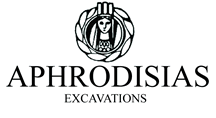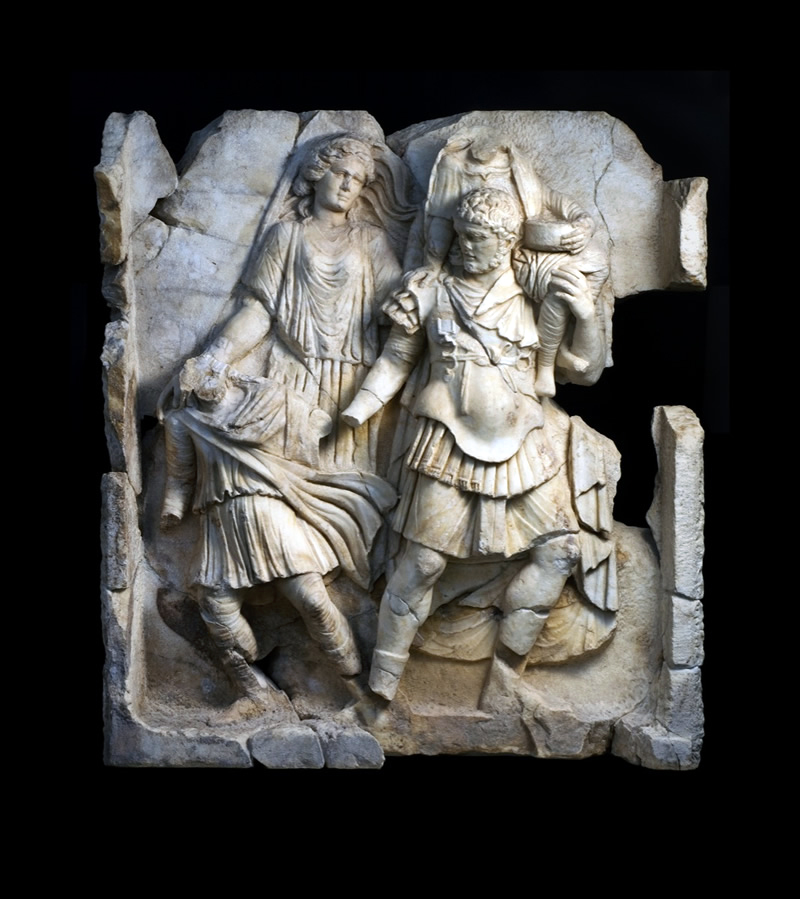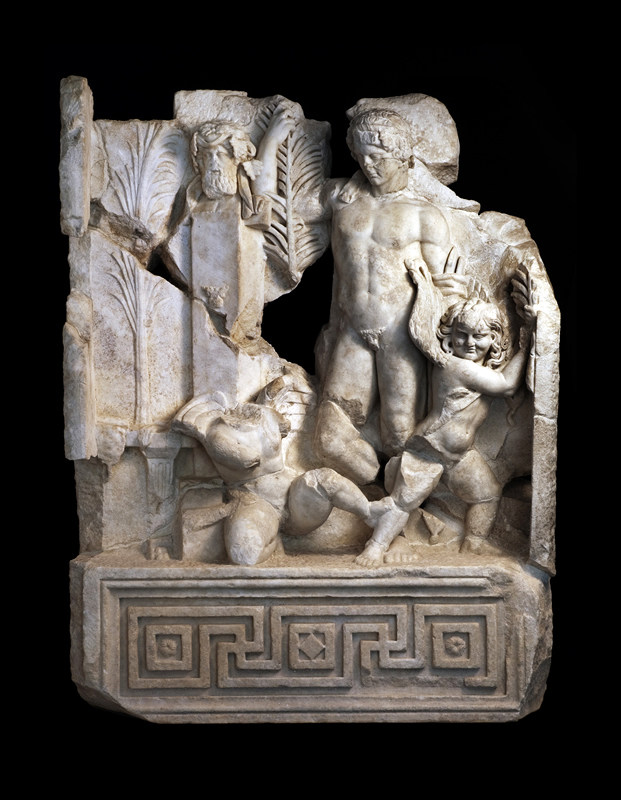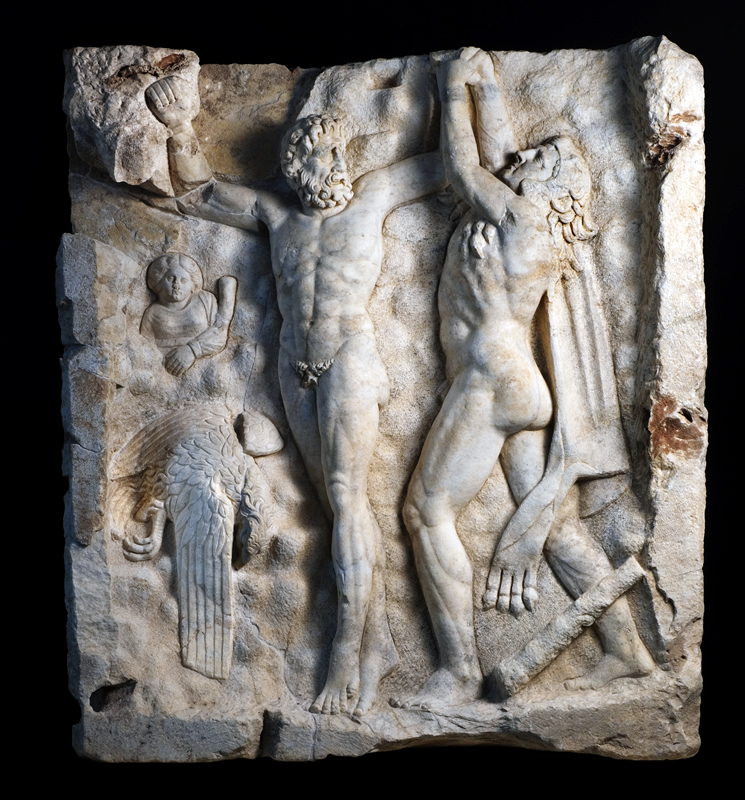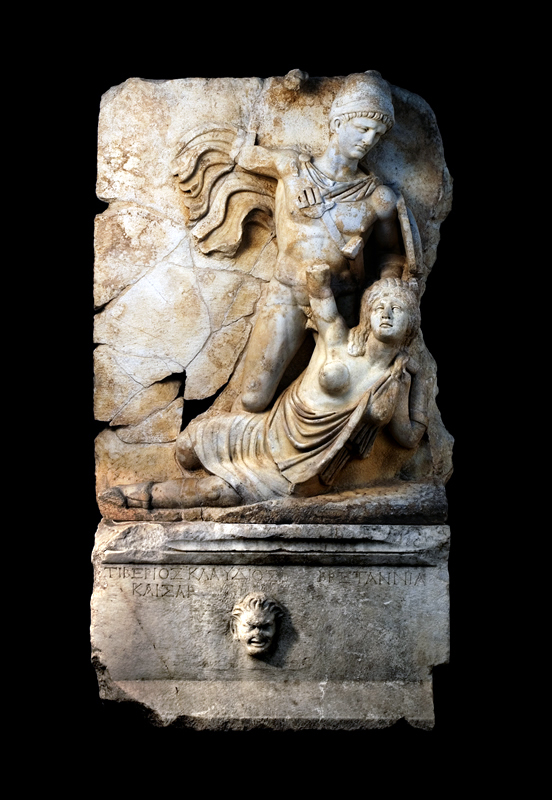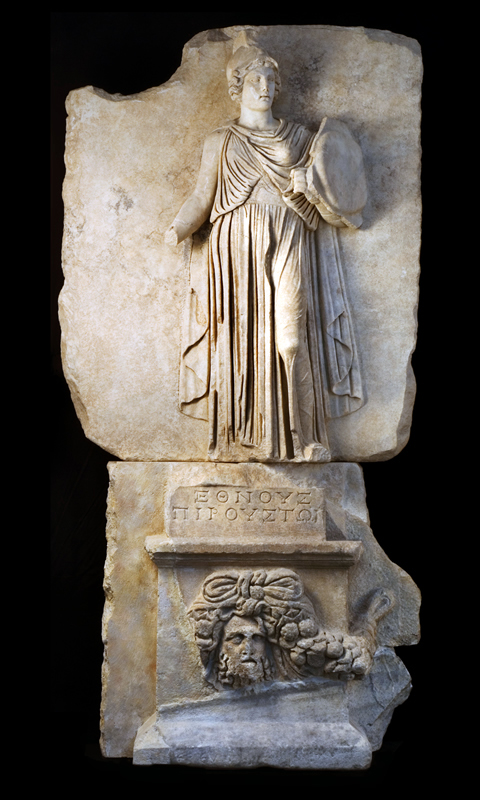Sebasteion reliefs
Aineias’ flight from Troy. Sebasteion, south building
The armored figure of Aineias moves to the right, carrying his aged father on his shoulder and leading his young son Iulus by the hand. Old Anchises carries a round base or box that held images of Troy’s ancestral gods. These three figures constituted the regular iconographic scheme of Aineias’ flight from Troy, on his way to Italy, which was widespread in the early imperial period. The local designers have added a floating figure of Aphrodite behind to give the scene a more specific, local meaning. The relief was carved from a large block that contained serious flaws in the stone, resulting in the oblique brown-stained breaks; they represent the fault-lines.
Agon (personification of competition). Sebasteion, south building
The scene is an allegory of athletic contest (or agōn). The pillar with bearded head is Hermes, the god of the gymnasium. Nearby is a palm of victory and a prize table with a victory ribbon on it. Two Eros figures, shown as winged babies, are struggling over a second palm branch (now mostly broken): they act out the idea of contest, which is personified in the youthful figure of Agon himself behind. He holds a third palm of victory and oversees the struggle. The Erotes fight on an allegorical plane: they do not compete in any specific athletic or gymnasium sport, but wrestle directly for the palm, the highest symbol of victory.
Prometheus and Herakles. Sebasteion, south building
A twisting naked figure of Prometheus hangs near the centre of the panel against a mountainous background, his hands manacled to the rocks above. His mouth is open, screaming in pain, as he looks with a distressed, emotional expression towards Herakles, his liberator. Zeus had meted out a terrible punishment to Prometheus for giving fire to man: he was tied to the Caucasus mountains and had his liver pecked out daily by an eagle. Herakles has shot the eagle and is undoing the first mannacle from Prometheus’ left hand. Herakles is naked except for a lionskin worn as combined cap and cloak, and his club lies below, across the lower right corner. At the lower left, the body of the dead eagle, shot by Herakles, is slumped over the rocks. A small mountain nymph, holding a throwing stick, appears among the rocks above the eagle. This is a highly effective hellenistic-style pictorial composition.
Claudius and Britannia, with inscribed base. Sebasteion, south building
The naked warrior Claudius is about to deliver a death blow to a slumped figure of Britannia. He wears helmet, cloak, and sword belt with scabbard. Britannia wears a tunic with one breast bare — like the Amazon figures on which she was modelled. The subject of the relief is identified by the inscribed base and the imperial portrait. The inscription reads: Tiberios Klaudios Kaisar – Bretannia. The invasion of Britain in AD 43 was the ‘signature’ conquest of Claudius’ regime.
Claudius with allegories of land and sea. Sebasteion, south building
The emperor strides across the panel in vigorous motion, framed behind by a billow of drapery, which in ancient iconography indicated floating, flying, and as here, divine epiphany. He receives in his right hand a cornucopia with the fruits of the earth from a small figure emerging from the ground. On the right he receives a steering oar from a sea figure or marine tritoness. She has fish legs and a fish-scale skirt. The cornucopia and the steering oar symbolize the prosperity of land and sea under the emperor’s rule. The composition is an arresting visualization of the Roman emperor as an all powerful hellenistic-style divinity as seen from the eastern provinces. The awkward, rather gauche handling of the proportions of the emperor’s body indicates that the composition was designed locally. There were no public monuments in Rome that portrayed such an elevated, panegyrical conception of the emperor’s role.
Nero and Agrippina. Sebasteion, north building
Agrippina crowns her son Nero with a laurel wreath. Agrippina carries a cornucopia, symbol of Fortune and Plenty, and Nero wears the armour and cloak of a Roman commander. He held a spear, now broken off, in his right hand and probably an orb (symbol of world rule) in his left hand. His helmet (removed for the crowning) lies on the ground at the side. Both figures are clearly identifiable by their portraits. The scene refers to the emperor’s accession in AD 54 and belongs before AD 59, the year in which Nero had Agrippina murdered.
Personification of Pirousti. Sebasteion, north building
The figure personifies a Balkan warrior tribe, defeated by Tiberius in AD 6-8, before he became emperor. She wears classical dress, cloak, and helmet, and carries a small shield and probably once a spear. A builder’s inscription (Piroustōn: engraved lightly in small letters on the background above and to the right of the figure’s shield) ensured that the relief was put on the correct base, inscribed ETHNOUS PIROUSTŌN.
